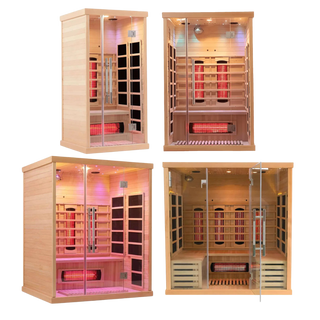Everything You Need to Know About Assembling and Installing a Sauna
Installing a sauna at home is an exciting project that can transform your space into a relaxing wellness retreat. Whether you're setting up an indoor or outdoor sauna, it's essential to ensure you have the right foundation, location, and assembly plan to maximize your sauna's performance and lifespan. In this guide, we’ll walk you through everything you need to know about assembling and installing your sauna, from choosing the perfect spot to preparing the proper foundation, and what to avoid.
- Choosing the Perfect Location for Your Sauna
The first step is determining whether you want an indoor or outdoor sauna. Each option has its pros and cons, so consider your space and your sauna goals.
- Indoor Saunas: Typically easier to install, indoor saunas can be placed in a basement, bathroom, home gym, or even spare bedroom. They require less insulation because they are already inside a temperature-controlled space. Make sure the room has good ventilation and access to electrical wiring (if the unit draws more than 10amp and requires wiring), especially if you're installing a traditional indoor unit.
- Outdoor Saunas: Outdoor saunas provide a beautiful, natural setting, often accompanied by the option of a cold plunge pool or ice bath nearby. However, they require more weather protection. You'll need to plan for outdoor wiring, waterproofing, and appropriate drainage to handle moisture over time.
Things to Consider for Both Indoor and Outdoor Saunas:
- Access to Power: Ensure the sauna location has easy access to electrical wiring. For most saunas, including traditional and infrared models, a dedicated power source is essential.
- Space for Ventilation: Proper ventilation is crucial for both user comfort and the longevity of your sauna. Choose a space with good airflow to prevent excessive moisture buildup.
- Privacy: Saunas are best enjoyed in private, peaceful settings. Whether indoors or outdoors, choose a location where you can relax without interruptions.
- The Right Foundation for Your Sauna
The foundation is one of the most important aspects of assembling a sauna. Without a stable and level base, your sauna may settle unevenly over time, leading to structural problems and reduced efficiency. Here's what you need to know about building the right foundation:
Outdoor Saunas:
- Concrete Slab: A concrete slab is the most recommended foundation for an outdoor sauna. It provides a stable, level surface that prevents moisture from seeping up from the ground. A 4-6 inch thick slab is usually sufficient for most saunas.
- Decking or Pavers: If you prefer a more aesthetic approach, treated wood decking or interlocking pavers are also suitable. Just make sure the surface is level and properly reinforced to handle the weight of the sauna and its occupants.
- Avoid Grass or Dirt: Never install a sauna directly on grass, dirt, or gravel. These surfaces are unstable and prone to water absorption, which can cause the sauna to shift or deteriorate over time; causing leaks and a lot of other issues.
Indoor Saunas:
- Concrete or Tile Flooring: For indoor saunas, two – four person units are fine to go on the carpet, though anything larger and it is worth considering concrete or tile floors. They are waterproof, durable, and easy to clean, preventing moisture buildup in your home. If the room has existing flooring like carpet or wood, it may be best to remove it and replace it with a moisture-resistant material.
- Raised Flooring: As an additional option for your large indoor traditional saunas, some prefer installing indoor saunas on raised platforms to improve air circulation underneath. Ensure any raised floor is sturdy enough to hold the weight of the sauna.
- Proper Assembly: Step-by-Step
While assembly instructions vary by sauna model, the general process is straightforward. Here's a basic overview of what to expect:
- Unpack and Inspect: After delivery, inspect all the parts to ensure nothing is damaged or missing. Make sure everything is dry and that it is not going to rain.
- Prepare the Foundation: Make sure the foundation is level and clean before starting assembly.
- Install Walls and Frame: Start by assembling the frame, then add the wall panels, securing each section properly.
- Sealing: For outdoor units, make sure everything is well sealed to protect your unit from the outdoor environment. Tighten the steel band and apply for sealant glue the following day to be sure.
- Install the Heater and Wiring: If you have an electric heater, ensure everything is wired up correctly and checked by a licensed electrician. For wood stoves, ensure you have proper ventilation and clearance for safety.
- Test the Sauna: Once assembled, test the sauna to ensure it heats up evenly and that the controls, lighting, and ventilation are working properly.
- Mistakes to Avoid When Installing Your Sauna
- Skipping Professional Help for Wiring: Sauna heaters require significant power. Always hire a licensed electrician to wire your sauna properly to avoid safety risks.
- Placing the Sauna on an Unstable Surface: Make sure the surface where you install the sauna is completely level. Any unevenness can cause doors and panels to misalign over time.
- Neglecting Ventilation: Without proper ventilation, moisture can build up, leading to mold or wood damage, especially in indoor saunas.
- Underestimating Space Requirements: Saunas require extra space for comfortable use. Don’t cram them into a tight area without enough room for people to move around or for the sauna to "breathe."
- Post-Installation Care and Maintenance
To keep your sauna in excellent condition, follow these tips:
- Regularly Clean the Sauna: Wipe down the interior after use and avoid using harsh chemicals that can damage the wood (warm water and vinegar in perfect).
- Check for Wear and Tear: Inspect the sauna periodically for any signs of wear, especially in high-humidity areas. Make sure the doors, heater, and electrical systems are functioning properly.
- Place a Towel During Use: While optional, to stop the wood from changing colour over time from the sweat and to keep your sauna as clean as possible, we suggest sitting on a towel during your sauna session.
- Inspection: Inspect the sauna periodically for any signs of wear, especially in high-humidity areas. Make sure the doors, heater, and electrical systems are functioning properly.
- Protect Outdoor Saunas: For outdoor models, ensure they are weatherproofed, and consider covering them when not in use to protect against harsh weather.
- Protective Oil: For traditional outdoor models, it is recommended to apply protective wood oil to the outside of the unit every six months to help keep the wood perfect. A oil that we recommend using is the CD50x - Bunnings
Installing a sauna can be a rewarding investment in your health and well-being. With careful planning, proper foundation preparation, and attention to detail during assembly, you can enjoy your sauna for years to come. At HealthHQ, we provide not only top-of-the-line saunas but also the expert guidance needed to ensure a seamless installation process.
Looking for the perfect sauna? Explore our range of high-quality indoor and outdoor models today at HealthHQ!








